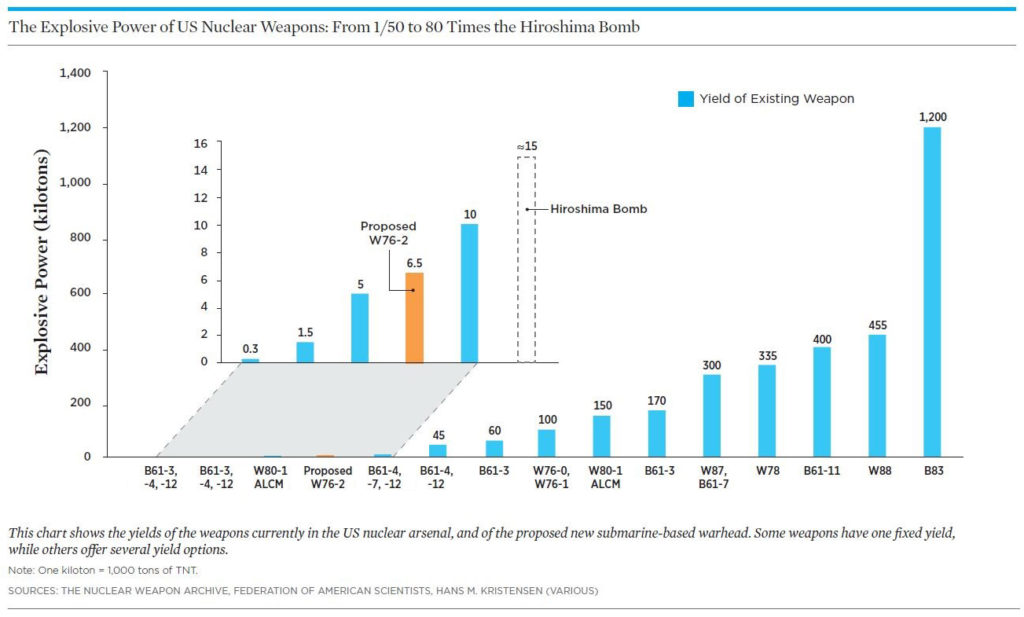The Trump administration plans to build new “low-yield” nuclear weapons that would be launched from Trident submarines. Its rationale? It insists they are needed to counter Russia’s low-yield weapons.
This plan has resulted in a lot of confused—or perhaps deceptive—verbiage on the part of some of our elected officials. They seem not to know or neglect to mention that the United States already deploys a wide array of low-yield nuclear weapons.
Or it could be that they have their own set of alternate facts?
Alternate Facts in the House
For example, on May 22, Mike Roger (R-Ala.), who chairs the Strategic Forces Subcommittee of the House Armed Services Committee, laid out his reasons for supporting the new warhead. Discussing the possibility of a Russian attack with low-yield weapons, he said:
“…[W]e have to understand Russia has this capability. … I think one of the reasons they don’t believe we would respond is we don’t have the capability [emphasis added] to do it without all-out nuclear war. They have to understand that we can, with precision, do exactly what they would do to us.”
Given Roger’s position in Congress, you would expect him to know quite a bit about US nuclear weapons. Yet he seems to believe that the United States has no low-yield nuclear weapons, so that the only US option would be to use its regular-size nuclear weapons and start an all-out nuclear war. (He also seems to believe that using low-yield nuclear weapons could not itself lead to an all-out nuclear war, but let’s ignore that for now.)
Alternate Facts in the Senate
More recently, Jon Kyl (R-Ariz.), who was then serving on the Senate Armed Services Committee, weighed in with a November 29 op-ed on The Washington Post website, “Why America needs low-yield nuclear warheads now.” He and his co-author Michael Morell, who is a former deputy director and acting director of the CIA, argue that the United States needs the new low-yield Trident warhead “because a high-yield, long-range U.S. response to Russia’s first, limited use of a low-yield nuclear weapon against a military target is not credible. The Russians believe we are not likely to risk a global thermonuclear war in response to a ‘tactical’ nuclear attack by them.”
Again, the claim is that if Russia were to use low-yield nuclear weapons, the United States would have only two options: no response or launching a global thermonuclear war by using its regular- size weapons.
Again, given the responsibilities and experience of these two men, one would expect them to know a fair amount about the US arsenal. Yet they seem not to know—or at least don’t acknowledge—that the United States has other options because it already deploys a wide array of low-yield nuclear weapons, and has for decades.
The Real Facts
Exactly what low-yield weapons does the United States have in its arsenal?
The B61 bombs—which include 150 deployed at US air bases in six NATO countries—have variable explosive yields. The lowest available option has an explosive power of 0.3 kilotons of TNT—just 2 percent of the yield of the bomb that destroyed Hiroshima. The bombs also can be set to a yield of 1.5, 10, 45 or 60 kilotons.
The United States also deploys air-launched cruise missiles with yields of 5 to 150 kilotons.
The United States is upgrading these weapons to extend their lifetimes for several decades and to add improvements, such as greater accuracy.
The planned new warhead—the W76-2—will have a yield of 6.5 kilotons and will replace some of the existing 100-kiloton W76 warheads on US submarines. It would add yet another weapon to the low-yield nuclear arsenal that our elected officials apparently don’t know exists.
You have to admit, though, the W76-2 will nicely fill in the gaping hole between 5 and 10 kilotons in the figure below.

Fig. 1 (Source: UCS)
